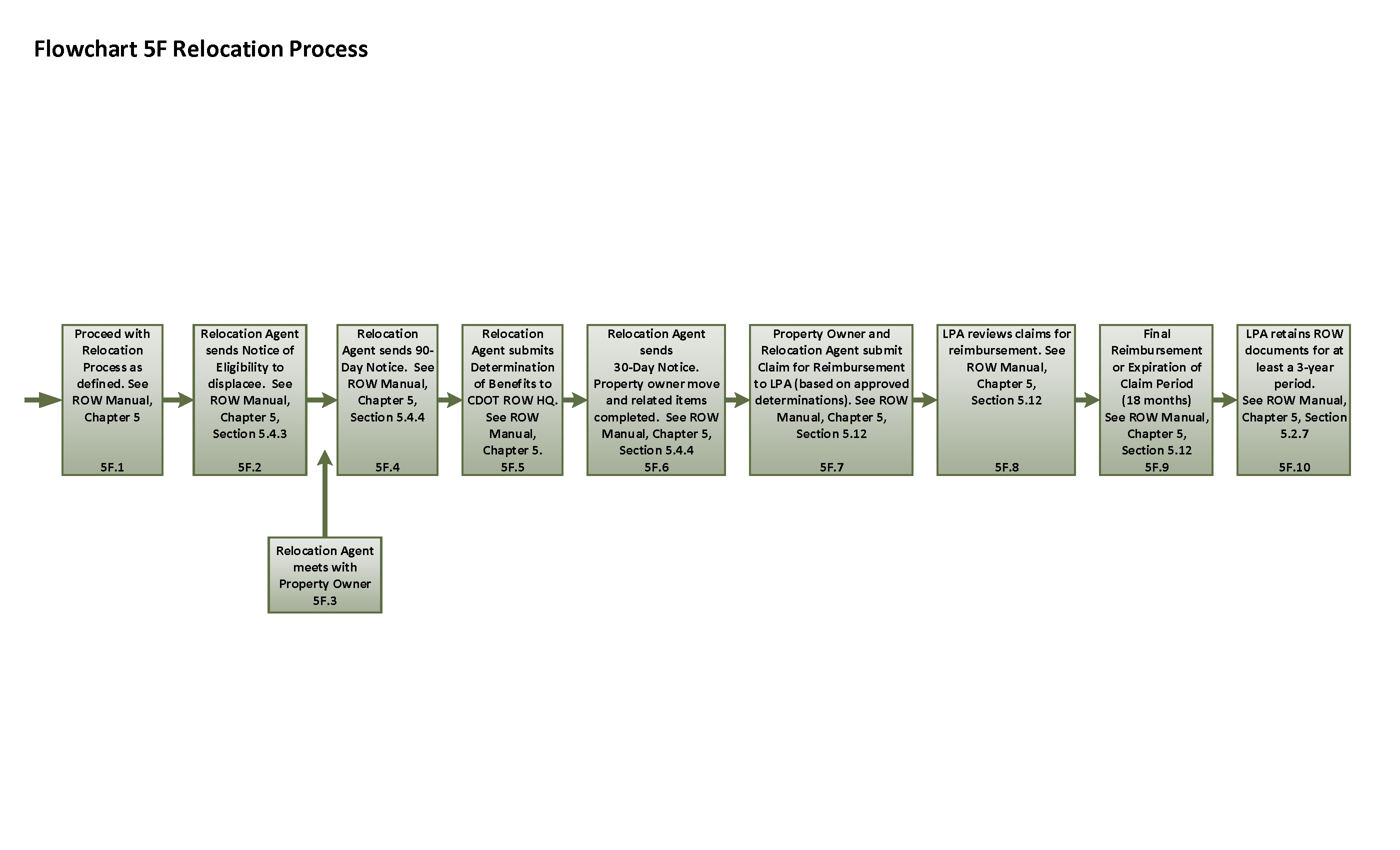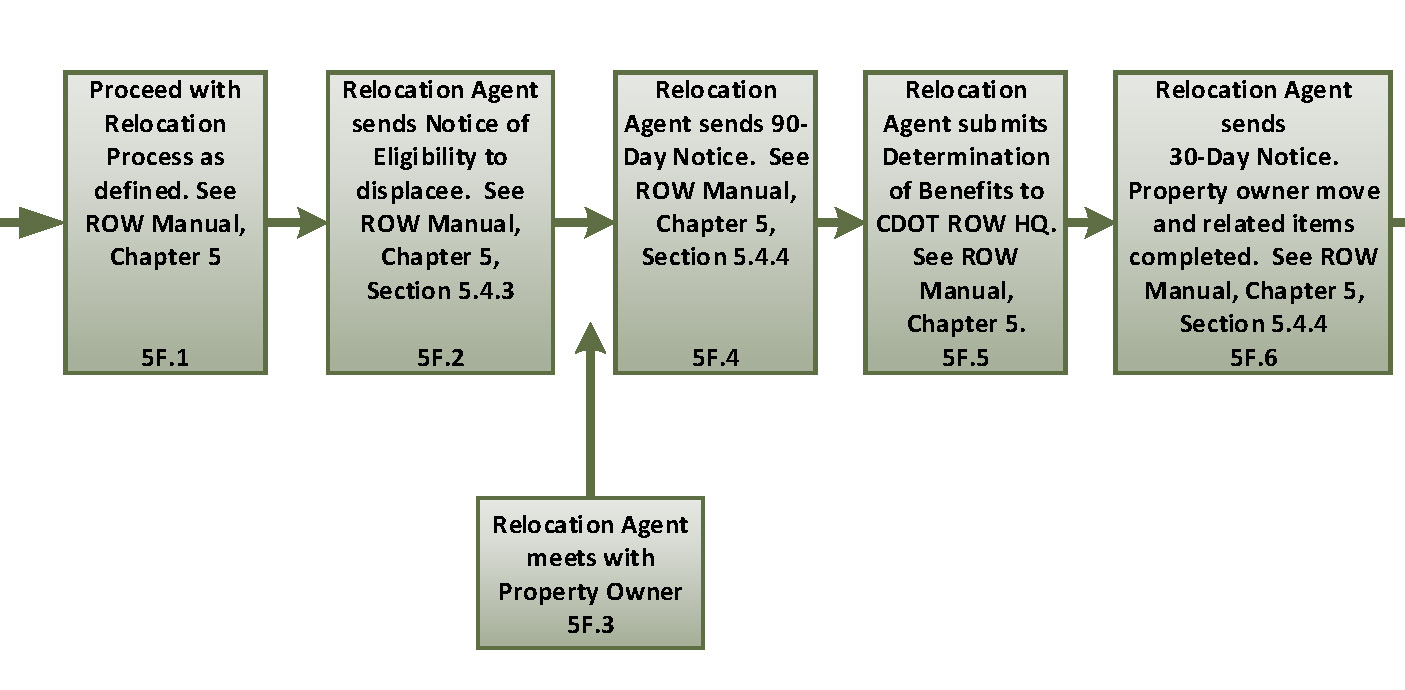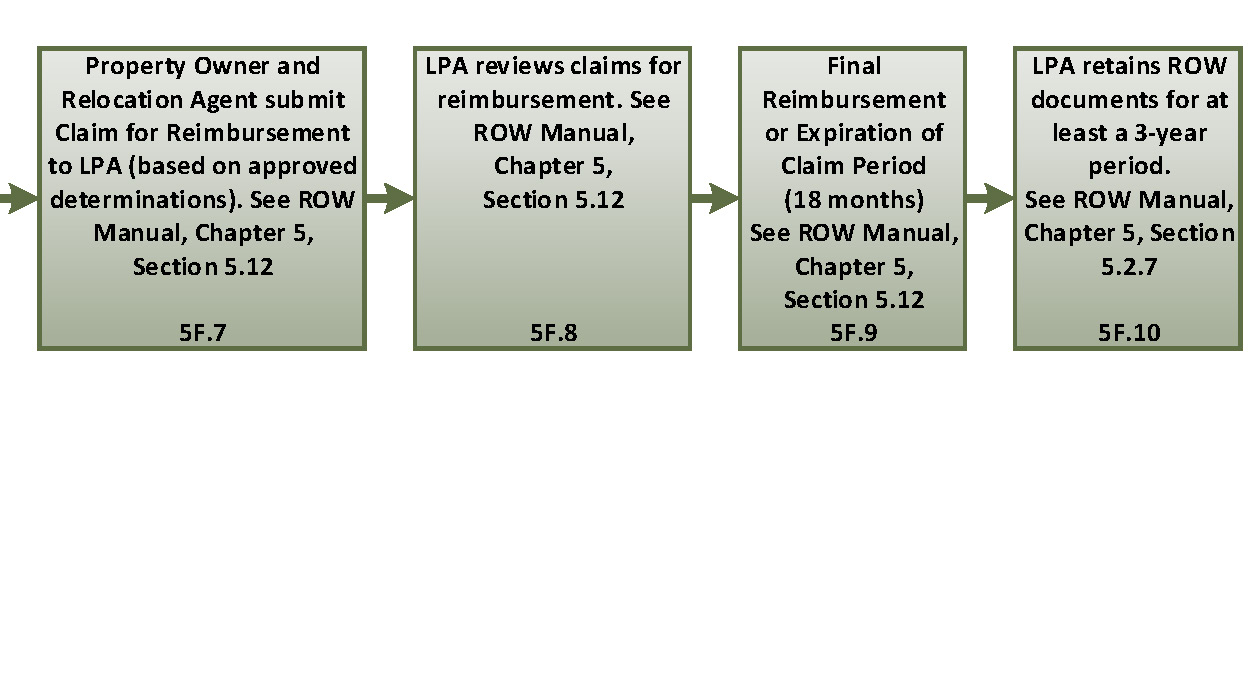Flowchart 5F: Relocation Process
Sometimes land needed for a transportation improvement is occupied. In such instances it may be necessary to relocate the occupants. These occupants may be families, individuals, businesses, farms or even non-profit organizations. The Uniform Relocation Assistance and Real Property Acquisition Policies Act of 1970 (Uniform Act) and FHWA regulations address the benefits and protections for persons displaced by transportation projects that are funded, at least in part, with federal money.
Among other benefits, the Uniform Act provides relocation payments for residential occupants and for businesses, farms, and non-profit organizations. These payments include moving expense payments and certain supplementary payments for replacement housing for residential occupants. In addition, the act provides certain protections such as requiring the availability of replacement housing for displaced persons, minimum standards for such housing, and required notices and information to be provided to all property occupants. Also, the law requires the provision of advisory services to project occupants to help them move successfully.
If your agency has determined that relocation is necessary for the transportation improvement, please notify your CDOT project manager and CDOT region ROW manager as soon as possible. See Chapter 5 of the CDOT ROW Manual for further information.
The Notice of Relocation Eligibility will be issued by the relocation agent under the local agency's direction. The Notice of Relocation Eligibility is a major step in the relocation process. The notice informs particular persons that they will be displaced by the project and thus will be eligible for relocation benefits appropriate to their situation (homeowner, tenant, business etc.).
Eligibility for relocation assistance begins on the date of a notice of intent to acquire, the initiation of negotiations, or actual acquisition, whichever occurs first. The trigger for this notice is the initiation of negotiations to acquire the real property where the person lives or conducts a business. The date on which this occurs generally is the date on which the property owner receives the initial offer to buy the property for the amount the agency has determined to be "just compensation."
The regulations require that the notice be provided promptly in writing to persons who will be displaced. Therefore, it should be issued on the same day as the offer to acquire the property or as soon thereafter as possible. The Notice of Relocation Eligibility should be delivered within seven days and no later than fourteen days; otherwise, the requirement of promptness will not be satisfied.
See Chapter 5, Section 5.4.3 of the CDOT ROW Manual for further information.
The relocation agent typically meets with the property owner or tenant early in the process to determine possible relocation benefits. This meeting can occur at the same time as delivery of the Notice of Eligibility.
The local agency's relocation agent sends the 90-day notice (also called the General Information Notice) which contains assurances for persons to be displaced. No one will have to move from a dwelling without at least 90 days advanced written notice. This is one of the most important protections that the Uniform Act and the regulations provide. A 90-day notice is not effective for a residential occupant unless a comparable replacement dwelling has been made. Realistically, a residential occupant does not have to move until at least 90 days after receipt of notice of replacement housing availability.
The requirement for the 90-day notice applies to situations in which an occupant is required to move. Where occupants move on their own before receiving a notice, it is not necessary to provide one.
See Chapter 5, Section 5.4.4 of the CDOT ROW Manual for more details about the 90-day notice.
The local agency's relocation agent submits a Determination of Benefits (CDOT Form 453) to CDOT ROW HQ.
The 90-day notice (see text box 5F.4) does not state a specific date, but informs the displaced person that in not less than 60 days the local agency's relocation agent will provide a second notice which will state a specific date by which a move will be required, and that this latter notice will provide no less than 30 days advance notice to move. The earliest date by which the local agency may require a move must be at least 90 days after the 90-day notice is given. The local agency must acquire the property in question before issuing this 30-day notice.
The property owner and relocation agent submit claims for reimbursement to the local agency. The claims must be based on approved determinations. Any claim for a relocation payment shall be supported by such documentation as may be reasonably required to support expenses incurred, such as bills, certified prices, appraisals, or other evidence of such expenses. A displaced person must be provided reasonable assistance necessary to complete and file any required claim for payment.
The local agency will review claims in an expeditious manner. The claimant must be promptly notified as to any additional documentation that is required to support the claim. Payment for a claim shall be made as soon as feasible following receipt of sufficient documentation to support the claim.
All claims for a relocation payment shall be filed with the local agency within 18 months after:
- The date of displacement for tenants
- The date of displacement or the date of the final payment for the acquisition of the real property, whichever is later, for owners
The 18-month time frame shall be waived for good cause. Such waiver shall be in writing and approved by the CDOT region ROW manager.
The acquiring agency must maintain all records of its right of way actions for at least three years after payment of the final voucher to demonstrate compliance with 49 CFR Part 24. After the three-year period, the acquiring agency should maintain adequate documentation to prove ownership (plans, legal descriptions, deeds, fair market value CDOT Form 930, original of parcel appraisals, etc.). For additional details refer to 23 CFR, 710 Subpart B, Program Administration; the FHWA Project Development Guide; and CDOT ROW Manual, Chapter 2, Plans.



